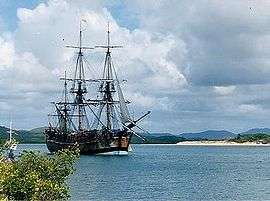Northumberland Islands
Australia's Northumberland Islands are a scattered island chain off the Queensland coast, located south-east of the city of Mackay roughly between the latitudes 21°S and 22°S. All islands are of the continental type. The island group was named by James Cook during his historic voyage along Australia's eastern seaboard in 1770, after the First Duke of Northumberland, Hugh Percy.[1] Both Cook and Matthew Flinders make note of the island group in their journals, Cook describing them as such:
- As soon as we got round the Cape [Cape Townshend] we hauld our wind to the Westward in order to get within the Islands which lay scatter'd up and down in this bay [Shoalwater Bay] in great number, and extend out to Sea as far as we could see from the Masthead; how much farther will hardly be in my power to determine; they are as Various in their height and Circuit as they are numerous.
The island group is remote, and apart from charter flights to Marble Island accessible only by private yacht.
The Northumberland Islands are further subdivided into smaller groups: the Bedwell Group, Beverley Group, Broad Sound Islands, Duke Islands, Flat Isles, Guardfish Cluster and Percy Group. The islands are listed below, with the geographical coordinates of the largest islands given. Only the major islands of each group are listed.
Bedwell Group
Name origin: Staff Commander E. P. Bedwell, surveyor [2]
- Calliope Island
- Connor Islet
- Innes Island
- George Island
- Poynter Island 21°50′S 149°47′E / 21.833°S 149.783°E
Beverley Group
Name origin: Unknown [3]
- Beverlac Island
- Digby Island 21°30′S 149°56′E / 21.500°S 149.933°E
- Double Island
- Henderson Island
- Hull Island
- Keelan Island
- Knight Island
- Minster Island
- Noel Island
- Prudhoe Island 21°19′S 149°41′E / 21.317°S 149.683°E
Broad Sound Islands
Name origin: Situated at the mouth of Broad Sound, a vast inlet named by Cook in 1770 [4]
- Long Island 22°10′S 149°53′E / 22.167°S 149.883°E
- Quail Island22°08′S 149°59′E / 22.133°S 149.983°E
- Tern Island
- Wild Duck Island 22°01′S 149°52′E / 22.017°S 149.867°E
Duke Islands
Name origin: Unknown [5]
- Alnwick Island
- Bamborough Island
- Cheviot Island
- Hexham Island 22°02′S 150°22′E / 22.033°S 150.367°E
- High Peak Island 21°57′S 150°41′E / 21.950°S 150.683°E
- Hunter Island
- Marble Island 21°59′S 150°11′E / 21.983°S 150.183°E
- Otterbourne Island
- Shields Island
- Steep Island
- Tweed Island
- Tynemouth Island
Flat Isles
Name origin: Named by Flinders in 1802 due to their height [6] - Avoid Island is the highest at 33 metres above sea level
- Aquila Island 21°58′S 149°33′E / 21.967°S 149.550°E
- Avoid Island
- Flock Pigeon Island 22°08′S 149°34′E / 22.133°S 149.567°E
- Red Clay Island
Guardfish Cluster
Name origin: Unknown [7]
- Bluff Island
- Curlew Island 21°37′S 149°48′E / 21.617°S 149.800°E
- Tinonee Peak Island
Percy Isles
Name origin: Named by Flinders in 1802 after the Duke of Northumberland's family name [8]
- Hotspur Island
- Middle Percy Island 21°39′S 150°16′E / 21.650°S 150.267°E
- North East Island
- Pine Islet
- Pine Peak Island
- South Percy Island21°46′S 150°20′E / 21.767°S 150.333°E
- Sphinx Island
- Walter Island
References
- ↑ "Northumberland Islands (entry 24762)". Queensland Place Names. Queensland Government. Retrieved 28 August 2015.
- ↑ "Bedwell Group (entry 2038)". Queensland Place Names. Queensland Government. Retrieved 13 September 2015.
- ↑ "Beverley Group (entry 2430)". Queensland Place Names. Queensland Government. Retrieved 15 September 2015.
- ↑ "Broad Sound (entry 4593)". Queensland Place Names. Queensland Government. Retrieved 13 September 2015.
- ↑ "Duke Islands (entry 10764)". Queensland Place Names. Queensland Government. Retrieved 13 September 2015.
- ↑ "Flat Isles (entry 12726)". Queensland Place Names. Queensland Government. Retrieved 13 September 2015.
- ↑ "Guardfish Cluster (entry 14927)". Queensland Place Names. Queensland Government. Retrieved 13 September 2015.
- ↑ "Percy Isles (entry 26441)". Queensland Place Names. Queensland Government. Retrieved 13 September 2015.
